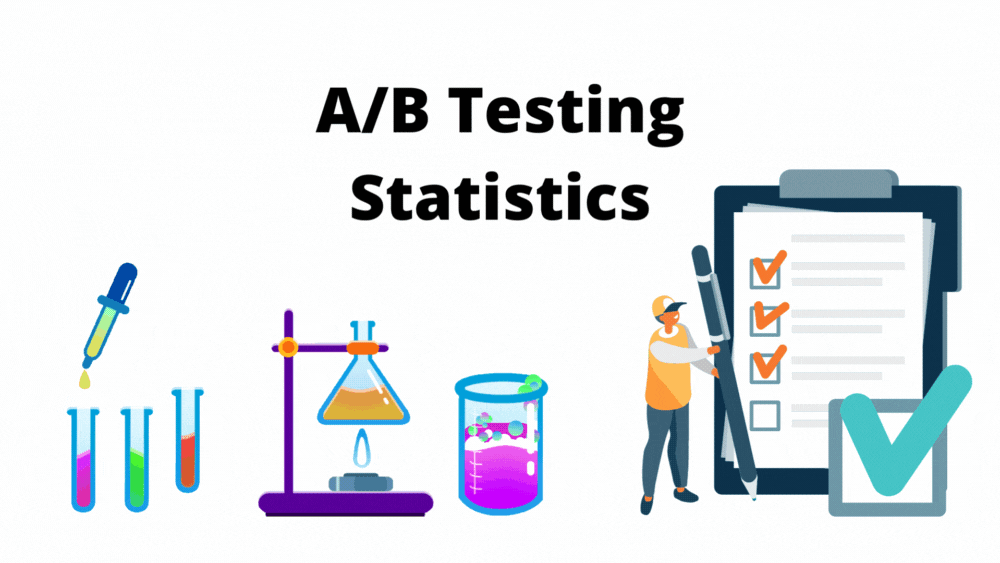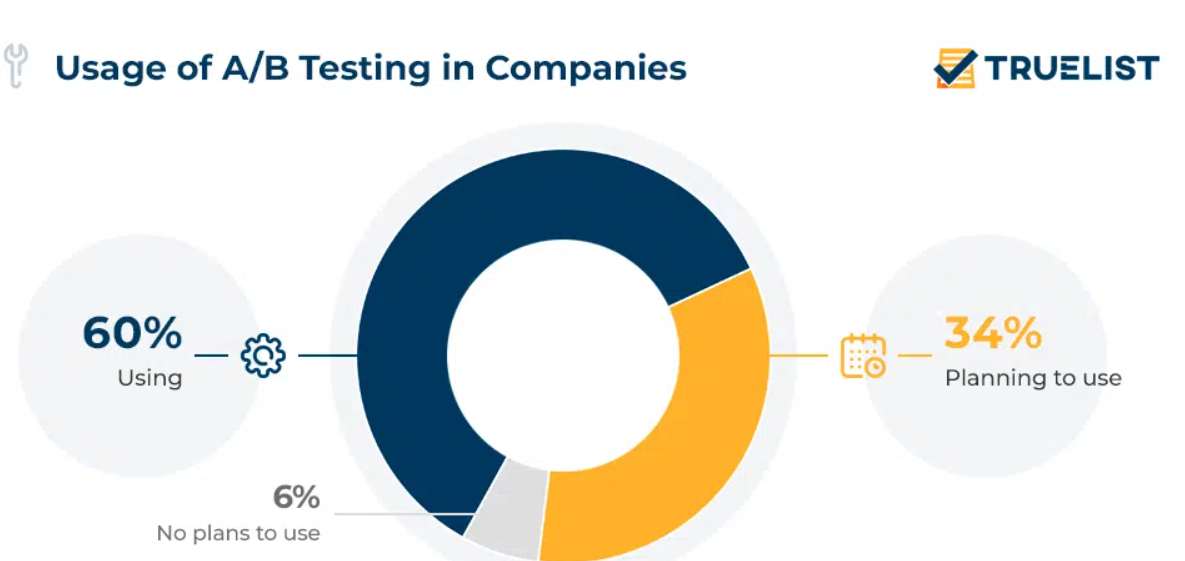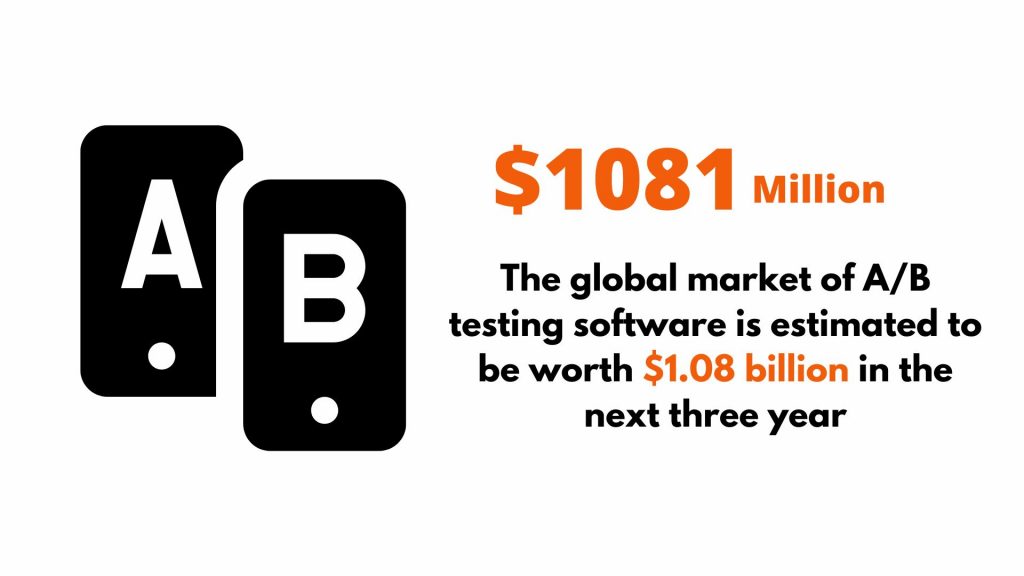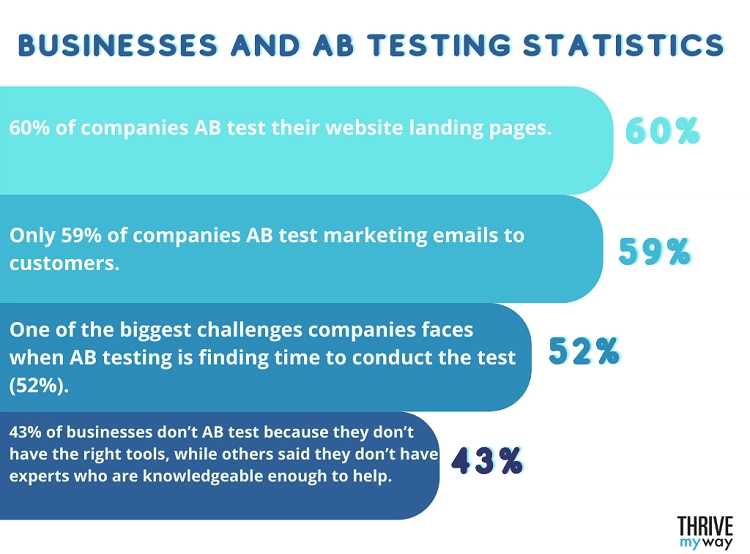Impressive A/B Testing Statistics 2024 For Businesses To Improve Their Marketing Strategy In The Future

Page Contents
A/B Testing Statistics: A/B testing relies on statistical analysis to draw meaningful conclusions. Statistical significance indicates the likelihood that the differences observed between two variations are not due to random chance. Analysts typically set a threshold, often at a 95% confidence level, to determine whether the results are statistically significant.
In 2024, businesses allocate significant resources toward A/B testing to enhance their marketing strategies and user experiences. It allows companies to test various elements such as website layouts, advertising campaigns, and product features to identify the most effective options.
A key aspect of A/B testing is measuring performance metrics such as conversion rates, click-through rates, and revenue. These metrics provide quantifiable data to evaluate the effectiveness of each variation. For example, a company may find that Version A of an email campaign generates a 10% higher conversion rate compared to Version B, indicating its superiority.
Editor’s Choice
- A/B testing can achieve statistical significance with as low as 5,000 unique visitors.
- Around 77% of firms worldwide conduct A/B testing on their websites.
- 60% of companies use A/B testing on their landing pages.
- The global A/B testing software market is projected to be valued at USD1.08 billion by 2025.
- Nearly 44% of businesses utilize split testing software.
- Only 7% of companies find A/B testing difficult to perform.
- Approximately 52.8% of Conversion Rate Optimization (CRO) professionals lack a standardized stopping point for A/B testing.
- Improved User Experience (UX) design resulting from A/B testing can potentially boost conversion rates by 400%.
- One out of every eight A/B tests leads to a significant change.
- 59% of firms conduct A/B testing on their email marketing campaigns.
- In the US, 93% of companies perform A/B tests on their email marketing.
- Simple subject lines attract 541% more responses than creative ones.
- Bing saw a 10-25% increase in revenue per search after conducting A/B tests.
- The A/B testing software market was valued at USD516.50 million in 2020 and is expected to reach USD1.24957 billion by 2028.
- 58% of companies use A/B testing for conversion rate optimization.
- 57% of A/B testers stop experiments upon reaching the expected results.
- 85% of businesses prioritize call-to-action triggers for A/B testing.
- 39% of companies use A/B tests on email subject lines, content, date and time, and preheaders.
- 71% of companies experiencing significant sales increases test their landing pages before publishing.
- Dell reported a 300% increase in conversion rates from A/B testing.
- Bing reportedly conducts over 1,000 A/B tests monthly.
- In Europe, only 20% of companies conduct A/B tests on their email marketing.
You May Also Like To Read
- SEO Statistics
- B2B Marketing Statistics
- Affiliate Marketing Statistics
- Digital Marketing Statistics
- Infographic Statistics
- Video Marketing Statistics
- Landing Page Statistics
- SMS Marketing Statistics
Facts About A/B Testing Statistics
- A/B testing is a widely used method, with 72% of companies incorporating it into their marketing strategies.
- Businesses primarily utilize A/B testing for website optimization, with 67% employing it for this purpose.
- Approximately 56% of organizations conduct A/B tests on email campaigns to enhance engagement and conversion rates.
- Challenges persist in A/B testing implementation, with 49% of companies facing difficulties due to limited resources.
- Despite its effectiveness, only 23% of businesses believe they have mastered A/B testing techniques.
- A/B testing can yield significant improvements, with 72% of companies reporting a boost in conversion rates through optimization efforts.
- Companies allocate a substantial portion of their budgets to A/B testing, with an average expenditure of USD 350,000 per year.
- The majority (81%) of marketers consider A/B testing crucial for understanding customer behavior and preferences.
- A/B testing is not without challenges, as 37% of companies struggle with data analysis and interpretation.
- The rapid evolution of digital technologies underscores the importance of A/B testing in staying ahead of competitors and meeting evolving consumer expectations.
General A/B Testing Statistics
#1. A/B testing statistics show that it is the top CRO method used by traders
A/B testing is the most popular CROP method to improve conversion rates with 60% of firms already using the tool and 34% of firms planning to implement it soon.

(Source: Smart Insights)
#2. The global market of A/B testing software is estimated to be worth USD1.08 billion in the next three year
As per A/B testing statistics, the yearly growth of the A/B testing software market is going to be steady at 12.1% until the end of 2025.

#3. Over half of the firms conduct A/B tests on their landing pages
As per research, many firms choose A/B testing to identify which of the landing pages has improved performing content.
#4. Around 77 % of firms conduct A/B testing on their websites
Most companies rely on A/B testing to identify design variations that deliver better conversions, images, and fonts. These factors help businesses reduce shopping cart abandonment by customers.

(Source: InvespCRO)
#5. 60% of firms say A/B testing is critical for improving their conversion rates
Though many causes affect conversion rates, the latest A/B testing statistics show that the majority of businesses think A/B testing is one of the best methods to optimize conversions.
#6. Nearly 44% of firms use split-testing software
While there are many benefits, automated A/B testing is not for all companies considering only 22 percent of businesses are content with their existing conversion rates.
#7. Successful A/B testing can lead to an increase of 50% in the average revenue per unique visitor for eCommerce sites
If A/B testing is performed successfully, it can result in massive benefits. A/B testing statistics show that one-third of A/B testers first evaluate elements such as the call-to-action button, 20% of A/B testers assess headlines, and 8% of testers examine website copies.
#8. Depending on the subject line, the traffic on the website can fluctuate by 500%
A/B testing trends show that trying various headlines and links to test user acceptance can pay off big time. A study on A/B testing has revealed that traffic on a website largely depends on subject lines.
#9. Statistical significance of A/B testing can be achieved with 5000 unique visitors
Being unsuccessful in drawing enough visits is one of the major reasons why many traders do not get the desired outcomes from A/B testing. A/B test stats show that only one in eight A/B tests is enough to bring significant change in conversion rates.
#10. Around 75% of the leading online retailers access A/B testing platforms
Using A/B testing platforms can help firms easily identify the vital hard points in the process of conversion. A/B testing platforms facilitate companies to generate greater ROI from their natural traffic. They help firms enhance user experience as well.
#11. Nearly 52.8% of CROs do not include a standardized stopping point for performing A/B testing
The utilization of the prioritization of frameworks is a crucial element of a firm's CRO process. A/B test analysis shows a higher number of organizations are now improving.
#12. Only 7% of businesses believe that performing A/B tests is hard
More than two-thirds of companies believe that conducting A/B testing to identify the most preferable features based on users' preferences is not a tough task.
#13. A/B testing secures 4.3 out of 5 CRO methods efficiency ranking by optimization experts
Conversion rate optimization experts highly recommend A/B testing.
#14. Only 28% of traders are happy with their conversion rates after performing A/B testing
It is essential to know how to conduct A/B testing properly. It is only efficient when it is done in the right way.
A/B Testing Email Statistics and Trends
#15. Emails with real persons' names as senders can result in 0.53% more opens
Email marketing A/B testing trends show that at times, small figures can lead to a significant improvement on a big scale.
#16. Around 93% of firms in the US perform A/B testing on their email promotion campaigns
Marketers in the US have been the first ones to implement A/B testing data in their promotion strategies. At present, most companies in the US rely on this approach. Around 79% of firms in France use A/B testing in their email marketing drives.

(Source: Marketing and)
#17. Nearly 59% of companies perform A/B testing on emails
A/B statistics related to email marketing show that apart from 59% of companies using this tool, another 58 percent of firms conduct A/B tests on paid search campaigns.
#18. Experts believe that simple headlines receive 541% more responses as compared to creative subject lines
Users appear to like simple headlines in email subjects rather than creative subject lines. A/B testing statistics show that keeping headlines straight and precise is more valuable to potential consumers.
#19. About 39% of firms around the globe perform A/B tests on the subject lines of emails
39% of companies around the world start their A/B testing with headlines in emails. They find testing the email's subject line more important. Nearly 37% of them evaluate the content, and 36% of firms test the send dates and timelines.
#20. Improved UX design as an outcome of A/B testing can lead to a conversion increase of 400%
Research shows that an improved UX design resulting from A/B tests can lead to a massive increase in the rate of conversion. If a website is not converting properly, it is not good for the company.
A/B Testing And Other Businesses Statistics
#21. The Obama Campaign generated USD75 million using A/B testing software
The US Presidential Campaign 2008 run by former US President Barack Obama is one of the best examples of A/B testing efficiency. Obama's digital marketing team used the tool to test photos, website layouts, and videos that boosted the sign-up rate of the campaign's website by 140% generating a massive fund of USD75 million.
#22. As per A/B testing statistics, Microsoft Bing performs more than 1000 A/B tests each month
Microsoft is one of the giant firms that use A/ B testing to optimize the search engine, Bing.
#23. Google conducted around 7000 A/B tests on its search algorithm in 2011
A/B testing statistics indicate that giant firms use this tool to optimize their products as well such as Amazon, Netflix, and eBay.
#24. Google performed its first A/B test in 2000
A/B testing facts reveal that now these days Google exceeds 10000 A/B tests per year.
#25. Google performed A/B testing for 50 different shades of blue for their Call-To-Action button
For maximum conversion of users, the company tested 50 shades of blue for its CTA using A/B testing analysis for colors. Other companies also conducted this test to improve conversions.
#26. Microsoft Bing improved its revenue by 12% using an A/B test
In 2012, with the idea of changing the display of ad headlines in a Bing search, the company witnessed a massive increase of USD100 million in its yearly revenues in the US.
#27. HubSpot garnered 131 leads due to a slight change in open rate through an A/B experiment
Email marketing A/B testing statistics reveal that HubSpot received 131 additional leads just by using a personalized name for the sender in their email marketing strategy as a part of their A/B testing experiment.
#28. 75% of enterprises utilize A/B testing on their websites.
 (Source: thrivemyway.com)
(Source: thrivemyway.com)
#29. 60% of companies conduct A/B testing on their website landing pages.
#30. Only 59% of businesses perform A/B testing on marketing emails to customers.
#31. One of the primary challenges faced by companies in A/B testing is finding time to conduct the test, with 52% citing this as an obstacle.
#32. 43% of businesses do not conduct A/B tests due to a lack of appropriate tools.
#33. Additionally, 28% of companies refrain from A/B testing because they lack experts with sufficient knowledge to assist them.
A/B Testing Recent Development
- Growing Use in Digital Marketing: The A/B testing software market is projected to grow significantly, with an estimated value reaching over USD1.2 billion in 2023 and expected to surpass USD3.67 billion by 2033, indicating a strong demand for A/B testing solutions in digital marketing strategies.
- Enhanced User Experience and Conversion Optimization: Companies are increasingly utilizing A/B testing to improve website design and user experience, potentially boosting conversion rates by up to 400%. This emphasis on better UX design through testing highlights its critical role in enhancing online performance.
- Wide Adoption Across Industries: A/B testing is widely adopted, with 77% of companies implementing it on their websites to test various elements such as design, content, and user pathways. This wide adoption showcases its versatility and effectiveness in optimizing web presence.
- Significance in Email Marketing: Approximately 59% of companies engage in email A/B testing, demonstrating its importance in refining email marketing campaigns for higher engagement and conversion rates.
- Impact on Revenue: Companies like Bing have seen substantial benefits from A/B testing, with improvements in revenue per search ranging from 10% to 25%. This underscores the financial impact of A/B testing on business outcomes.
- Ease of Implementation: Contrary to common perceptions, A/B testing is not deemed difficult by the majority of businesses, with only 7% finding it challenging. This suggests that A/B testing is accessible and manageable for most companies looking to optimize their digital strategies.
- Influence on Marketing Decisions: Over 50% of marketers rely on A/B testing to enhance conversion rates, indicating its critical role in informed decision-making and strategy optimization in the marketing domain.
- Global Adoption and Regional Growth: The A/B testing software market is experiencing robust growth worldwide, with notable expansions in India, the United Kingdom, China, Australia, and Japan, driven by the increasing emphasis on data-driven decision-making and website optimization.
Conclusion
In conclusion, the realm of A/B testing is witnessing substantial growth and adoption, as indicated by recent statistics. With 75% of enterprises leveraging A/B testing on their websites and 60% conducting tests on landing pages, it's evident that businesses recognize its importance in optimizing digital strategies. However, there are areas for improvement, such as the fact that only 59% of companies are utilizing A/B testing for marketing emails to customers.
Challenges persist, with 52% citing time constraints as a barrier, while 43% struggle due to a lack of appropriate tools. Moreover, 28% of companies face difficulties stemming from a shortage of experts. As a market research analyst, it's clear that while A/B testing offers significant benefits, addressing these challenges will be crucial for businesses looking to maximize their effectiveness and stay competitive in today's dynamic market landscape. With the global A/B testing software market projected to reach USD1.08 billion by 2025, organizations must overcome these obstacles and harness the full potential of A/B testing to drive growth and success.
FAQ.
A/B testing helps marketers, businesses, or companies to create careful and significant changes to their user experiences while gathering data on the outcomes.
The power, which is also known as Beta can be defined as the potency of the test to identify a real difference in the variant.
A/B testing finds out which of the two variants of a page or something delivers the best outcomes for a specific business.
Apart from web pages and landing pages, A/B testing can be performed on CTA, emails, and PPC campaigns as well.
Split testing considers the fact that traffic is divided into two equal splits between the existing variations, while A/B testing takes up two web pages or website versions that are contending against each other.

Barry is a lover of everything technology. Figuring out how the software works and creating content to shed more light on the value it offers users is his favorite pastime. When not evaluating apps or programs, he's busy trying out new healthy recipes, doing yoga, meditating, or taking nature walks with his little one.



